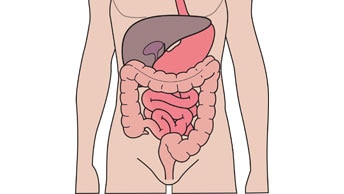The stomach

When you eat, the food travels down a long, narrow tube called the food pipe into your stomach. Here, the food is churned into smaller pieces and your digestive juices turn it into liquid.
The small bowels
The journey continues as the contents of your stomach move into the small bowel (ileum), where digestion finishes. Your body absorbs the nutrients it needs for energy, growth and building new cells and channels these into the bloodstream.
The large bowel
When all nutrition has been absorbed, the remains move into the large bowel (colon), where your body absorbs more fluid to make the waste more solid. The muscles in your colon wall then push any waste forward into your rectum, where it passes out of your body through your anus, with the aid of the sphincter muscles, as stool.
In a colostomy operation, part of your large bowel (colon) is brought to the surface of your abdomen to form a stoma (opening). A colostomy is usually made on the left-hand side of your abdomen, but may in some circumstances be on the right-hand side. When a colostomy is made on your abdomen it alters the usual way you go to the toilet to pass faeces. Instead of coming out through your anus, your faeces will pass through the stoma. The passing of faeces is usually controlled by a special sphincter muscle in the anus. However, the main difference for you when you have a stoma, is that you are no longer able to hold on to or have control over, when you need to pass faeces. You also do not have any control over when you pass wind or flatus.
In an ileostomy operation, part of your small bowel (ileum) is brought to the surface of your abdomen to form a stoma (opening). An ileostomy is usually made on the right hand side of your abdomen, but may in some circumstances be on the left hand side. When an ileostomy is made on your abdomen, it alters the usual way you go to the toilet to pass faeces. Instead of coming out through your anus, your faeces will pass through the stoma. The passing of faeces is usually controlled by a special sphincter muscle in the anus. However, the main difference for you when you have a stoma, is that you are no longer able to hold on to or have control over, when you need to pass faeces. You also do not have any control over when you pass wind or flatus.